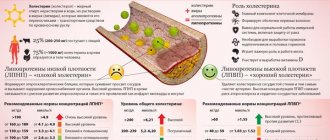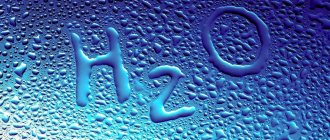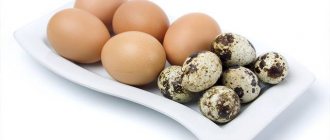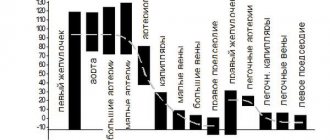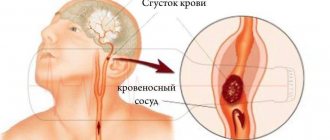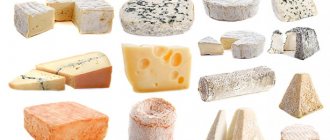Nutritional value of shrimp
Magnesium and potassium in shrimp have a beneficial effect on the cardiovascular system
Not so long ago, shrimp, along with lobsters, lobsters and other seafood, were considered a delicacy, food for the elite. Now these delicious crustaceans are increasingly found not only on the holiday table, but also on the everyday table of many people.
Shrimp are loved not only for their original taste, but also for their low calorie content, which allows them to be consumed in various diets. 100 g of these crustaceans contains:
- proteins – 20 g;
- fat – 1 g;
- carbohydrates – 0 g.
The nutritional value of shrimp is only 97 kcal per 100 g.
In addition, these seafood contain all B vitamins, as well as A, C, E, D, PP and K. Micro- and macroelements found in shrimp make up almost the entire periodic table of Mendeleev:
- magnesium;
- calcium;
- potassium;
- sodium;
- copper;
- iron;
- phosphorus;
- zinc;
- selenium;
- iodine.
100 g of shrimp meat contains the daily requirement of iodine necessary for the body, as well as 65% selenium and 25% iron, which support the functioning of the brain, heart muscle, strengthen blood vessels and help improve immunity. In terms of the content of these microelements, shrimp rank second after squid.
Benefits and harms
At the end of the 20th century, scientists claimed elevated cholesterol levels in sea crayfish. Is this really true, is there cholesterol in shrimp? And how much cholesterol is in shrimp? In 1996, studies were carried out, as a result of which it was found that crustaceans contain 160 mg of an organic compound.
The amount of cholesterol in shrimp and squid is higher than in other crustaceans. However, scientists have found that the cholesterol contained in shrimp is not able to accumulate in the body.
The safety of shrimp meat is explained by the fact that the product does not contain saturated fats, and the cholesterol found cannot be absorbed into the blood. Australian scientist Renaka Karappaswamy worked on the research.
As the shrimp cook, they turn a bright red color. This occurs due to the presence of astaxanthin in the product, a substance that acts more effectively on the body than antioxidants found in fruits and vegetables.
The effect of astaxanthin exceeds the effect of vitamin E. The substance helps protect human cells from aging, participates in the process of exfoliation of epithelial tissue and protects the body from external toxic influences.
Shrimp meat contains iodine, sodium, magnesium, folic acid
Other beneficial properties of shrimp
In addition to the listed beneficial substances contained in crustaceans, it is worth highlighting other elements that are part of sea crayfish. The product contains a large amount of:
We recommend reading:
What foods are high in cholesterol?
- vitamins A, E, C;
- calcium;
- Selena;
- zinc;
- phosphorus;
- iodine;
- copper;
- healthy omega-3 fats.
By systematically eating shrimp, a person will look slimmer, more cheerful and younger. The low percentage of saturated fats contained in shrimp meat has a beneficial effect on the functioning of the cardiovascular system.
You can only eat shrimp that have been properly cooked. This way, the dish will retain the maximum amount of nutrients. It is recommended to eat no more than 300 g of seafood at a time, so as not to provoke an increase in the level of harmful cholesterol.
Experts do not recommend eating crustaceans:
- together with alcohol, sweet carbonated drinks or tea;
- baked goods or pasta;
- with meat and mushroom dishes, since the combination of such products provokes an excess of proteins.
It is best to serve seafood with dill, which promotes better absorption of vitamins and microelements and the removal of bad cholesterol from the body.
Crustacean meat increases immunity and strengthens the nervous system
Shrimp, like any other product, can bring not only benefits, but also harm. People with allergies should eat small amounts of crustaceans, as they often cause allergic reactions and kidney problems.
If you have diabetes, it is better to avoid eating shrimp meat, as the product increases harmful cholesterol. Imported seafood quite often contains antibiotics, which entrepreneurs use to treat the product to avoid rapid spoilage of the product. Unfortunately, businessmen do not understand the harm they cause to people's health.
If the seller does not comply with the storage conditions of the product, then the beneficial properties of the product are lost. If you ignore the recommended temperature for storage, shrimp meat accumulates harmful substances.
You should only purchase shrimp that were caught in environmentally friendly areas. Otherwise, crustaceans are saturated with toxic substances, which leads to poisoning. Such foods sharply increase bad cholesterol.
Before making a purchase, you should carefully read the place from which the product was imported and make sure that there is a quality mark. Crustaceans should be practically free of ice, which will indicate proper storage.
Useful properties of shrimp
Due to its high protein content, eating shrimp helps build muscle and is recommended for people who exercise intensively. Protein is involved in the production of collagen, which maintains skin firmness and elasticity, preventing the appearance of wrinkles. The inclusion of shrimp in the diet has a positive effect on the functioning of many body systems:
- prevents the development of diseases of the cardiovascular system;
- normalizes blood pressure;
- increases brain activity and prevents the onset of Alzheimer's disease;
- normalizes the nervous system, is an antidepressant;
- eliminates the harmful effects of free radicals and toxins;
- strengthens teeth, rejuvenates skin;
- prevents thyroid pathologies;
- helps strengthen immunity and overall health of the body.
It has been proven that shrimp can prevent the appearance and development of cancer. If you include them in the menu once a week, you can slightly reduce the risk of intestinal and stomach cancer.
Do shrimp raise cholesterol or not?
Cholesterol is a lipid necessary for the human body to function. It is an integral part of cell membranes, participates in the formation of hormones, ensures the normal functioning of the digestive system and brain activity.
The vast majority is produced by the liver, and only a small amount comes from food. If the intake of cholesterol from food increases, the body automatically reduces its production, and vice versa.
How much cholesterol is in shrimp
The benefits of including shrimp and other seafood in your diet are obvious. But many people are concerned about the following questions: How much cholesterol does shrimp contain? Will their frequent use lead to the formation of blood clots and atherosclerosis?
100 g of shrimp meat contains 195 mg of cholesterol. That is, a serving of 350 g contains the body’s daily need for this substance. It is not for nothing that shrimp are considered the “cholesterol leader” among all seafood.
But, it should be taken into account that for cholesterol to settle on the walls of blood vessels and clog them, the presence of fats is necessary, and there is negligible amount of them in shrimp - only 1%. Thus, even high cholesterol content does not harm the body if you eat shrimp meat in moderation.
Frying shrimp in vegetable or butter dramatically increases the fat content of the prepared dish, helping to increase the concentration of cholesterol in the blood. Therefore, for shrimp to be beneficial, they should only be boiled.
Can you eat shrimp if you have high cholesterol?
There is an opinion among the population that it is harmful for patients with high levels of cholesterol in the blood to eat shrimp meat. Is it so?
During a biochemical blood test, lipid fractions are determined. They include low-density lipoproteins, total cholesterol, high-density lipoproteins, triglycerides and calculate the atherogenicity coefficient. It is the latter indicator that determines the risk of developing atherosclerotic lesions of the vascular wall. The higher the concentration of LDL (this is the so-called bad cholesterol), the higher it is.
The regular presence of crustaceans in the human diet increases the level of HDL (this is good cholesterol). Thus, the general condition of patients whose pathological process is characterized by lipid metabolism disorders improves.
Attention! A high concentration of omega-polyunsaturated fatty acids helps get rid of bad lipids, maintaining the normal functioning of brain structures, heart and blood vessels. This is achieved by improving blood composition and reducing the load on the working myocardium.
Is there bad cholesterol in shrimp?
The effect of cholesterol on the body
Shrimp do not increase the level of “bad” cholesterol in the body
There is a misconception that eating foods with high cholesterol levels is harmful to human health. However, research by scientists has shown that cholesterol enters the blood not only from food, but is also produced by the body, since it affects the following life processes:
- serves as a material for the construction of cell membranes;
- affects the production of serotonin in brain cells;
- takes part in the synthesis of aldosterone and hydrocortisone - hormones of the adrenal cortex;
- speeds up metabolism.
In addition, after numerous experiments, it was found that there are two types of cholesterol: good and bad.
Good molecules move freely in the blood and are not deposited in the form of plaques inside the vessels. On the contrary, they bind bad cholesterol and remove it from the body. It is this that, when accumulated, becomes the cause of atherosclerosis and increases the risk of strokes and heart attacks. But it also helps remove toxins and other harmful substances from the blood.
Thus, the body needs both good and bad cholesterol to function properly. The main thing is that its indicators do not exceed acceptable standards.
- poor – less than 3.5 mmol/l;
- good – less than 1 mmol/l;
- Total cholesterol is less than 5.3 mmol/l.
Returning to shrimp, we can say that their consumption leads to an increase in good cholesterol and in moderate doses does not harm the body.
Benefits of shrimp
Usually seafood is served in the form of various snacks when drinking beer. But you can safely mix them into salads, prepare soups or porridges, as well as hot dishes based on them.
Interesting! Given the fact that crustaceans are low in calories, high in protein and healthy fatty acids, they are often included in the menu of various dietary recommendations for weight correction.
What are the benefits of seafood:
- helps in building muscle mass;
- improves skin elasticity;
- helps maintain visual acuity;
- protects the circulatory system from negative influences;
- improves the body's immune response when exposed to adverse factors;
- helps improve performance;
- keeps nails strong and eliminates hair fragility;
- normalizes the condition of patients suffering from bronchial asthma;
- prevents the formation of blood clots;
- has an anti-inflammatory effect;
- helps normalize hormone levels;
- The iodine contained in crustaceans has a stimulating effect on the function of the thyroid gland.
Shrimp have a positive effect on male potency and the production of the main male hormone - testosterone. This is due to the fact that they are rich in zinc and selenium, as well as fatty amino acids, which take part in the process of male hormone synthesis.
Selenium and vitamin E, which are found in crustaceans, can reduce the risk of developing malignant tumors. But for this they will have to be consumed daily.
They are beneficial for the development of children and for pregnant women. The rich vitamin and mineral composition contributes to the normal formation of organs and systems of the fetus. During the period of active growth of the child, it has a strengthening effect on the teeth and skeletal system.
Shrimp bring invaluable benefits to the female body:
- reduce the severity of premenstrual syndrome;
- reduce the tendency to depressive disorders;
- increase stress resistance;
- contribute to the normalization of the production of female sex hormones.
Attention! But to get all these positive effects, you need to eat enough seafood every day. If you use it occasionally, the desired result will not be obtained.
Shrimp for the female body
Healthy nutrition experts strongly recommend that girls and women include shrimp in their menus more often. They claim that the substances contained in these seafood have a positive effect on the female body:
- reduce pain during menstruation;
- promote the production of estrogen – the hormone of beauty and youth;
- reduce nervousness;
- prevent depression;
- improve your mood.
Shrimp should be present in the diet of women during pregnancy. Thanks to their unique composition, they replenish the balance of vitamins and minerals and contribute to the normal development of the fetus.
Shrimp replenish the balance of vitamins and minerals during pregnancy
What scientific research says
Renowned nutritionist David Haber, author of What Color Is Your Diet, advocates for the health benefits of seafood and argues in its favor. He argues that the high cholesterol content of shrimp does not cause excess cholesterol in the blood and does not contribute to the development of atherosclerosis.
Scientific studies conducted by American and Australian scientists have confirmed this fact. Shrimps,
squid and other seafood, regardless of their cholesterol content, help remove excess cholesterol from the human body. Not only do squids contain taurine, which lowers blood cholesterol levels. They contain so much heart-healthy potassium that they have earned the name “heart balm.”
The American Heart Association also recognized the fallacy of shrimp as a cause of atherosclerosis.
A powerful antioxidant, astaxanthin, was found in shrimp. The role of antioxidants in preventing diseases such as heart attack or stroke is known. Their beneficial effect on the cardiovascular system and protective functions of the body has found application in the treatment of rheumatism, varicose veins, and other diseases.
Harm and contraindications
Like other seafood, shrimp can cause food allergies or other unpleasant conditions, so they should be consumed in moderation. It is also not recommended to eat crustaceans if you have pathologies of the kidneys, liver or intestines. Shrimp can be damaged in the following cases:
- if they previously lived in a polluted environment and absorbed toxic substances;
- if the product has been stored for a long time without freezing;
- if antibiotics or other chemical preservatives were used during production.
If you experience nausea, vomiting, headache or other signs of food poisoning after eating shrimp, you should definitely seek medical help.
Composition of shrimp
| Components | Availability in grams | Components | Availability in milligrams |
| Protein compounds | 18.9 | Iodine | 110.0 mcg |
| Carbohydrates | No | Calcium ions | 135 |
| Component ash | 1.7 | Iron molecules | 2200.0 mcg |
| Water | 77.2 | Magnesium mineral | 60 |
| Fat | 2.2 | Potassium molecules | 260 |
| Cobalt | 12.0 mcg | Microelement phosphorus | 220 |
| Sodium molecules | 450.0 mcg | Manganese | 110.0 mcg |
| Copper | 850.0 mcg | Molybdenum | 10.0 mcg |
| Fluorine | 100.0 mcg | Zinc | 2100.0 mcg |
Vitamin complex in shrimp:
| Vitamin | Availability in milligrams |
| Vitamin A - retinol | 0.01 |
| Vitamin B - carotene | 0.01 |
| Tocopherol - vitamin E | 2.27 |
| Ascorbic acid - vitamin C | 1.4 |
| Thiamine - vitamin B1 | 0.06 |
| Riboflavin - vitamin B2 | 0.11 |
| Folic acid - B9 | 13 |
| Niacin - vitamin B3 (PP) | 1 |
| Shrimp calories | 95 kcal |
Vitamins
Rules for cooking shrimp
Crustacean meat will only be beneficial if it is cooked correctly. A very popular recipe for seafood in batter, which is then fried in oil, is very popular in home and restaurant cuisine. It's delicious, but very harmful for those seeking to control cholesterol. Shrimp will be most beneficial if, after defrosting, they are immersed in boiling salted water for three minutes. The product prepared in this way can be served as an independent dish or added to vegetable salads.
How to properly store shrimp? If you bought frozen seafood, you need to put it in the freezer as soon as possible before it thaws. Fresh shrimp, if they will not be cooked immediately, are first washed, then placed on ice for several hours. Only after this can they be frozen. Shrimp should thaw naturally, without using boiling water or a microwave.
Contraindications
It is not safe for children under 3 years of age to eat shrimp, because the protein compounds in them can cause allergies.
Signs of a shrimp allergy include:
- Skin rash;
- Edema of the larynx;
- Irritation of the nasal mucosa;
- Pathology rhinitis;
- Dyspeptic manifestations - pain in the abdomen;
- Nausea, which may cause vomiting;
- Pain in the head and dizziness;
- Lethargy of the body;
- Anaphylactic shock.
Pain in the head and dizziness
Most of the negative manifestations occur due to the use of a low-quality product.
To prevent the consumption of low-quality goods, you need to know the rules for choosing them:
- Shrimp have a curled tail tip;
- The color of a quality shrimp can range from dirty green to brown-black;
- If the product is frozen, then each shrimp should be separately, and not in one lump;
- Light frost on the product is allowed, but not a large amount of ice;
- The packaging should contain maximum information about the place where the fish was caught and its composition;
- Shrimp from cold seas are smaller in size than their warm-water counterparts, but they contain more nutrients and Omega-3.
It is recommended to purchase unpeeled and unboiled shrimp, because the crustaceans will taste better in the shell after cooking.
Cholesterol in the blood: meaning, analysis and deviations from the norm, what to do if it’s elevated
Cholesterol is considered the main enemy of modern man, although several decades ago it was not given such great importance. Being carried away by new, recently invented products, often in their composition very far from those consumed by our ancestors, ignoring the diet, a person often does not understand that the main share of the blame for the excessive accumulation of cholesterol and its harmful fractions lies with himself. The “crazy” rhythm of life, which predisposes to metabolic disorders and the deposition of excess fat-like substances on the walls of arterial vessels, does not help fight cholesterol.
What's good and bad about it?
Constantly “scolding” this substance, people forget that people need it, since it brings many benefits. What's good about cholesterol and why shouldn't it be eliminated from our lives? So, its best aspects:
- Secondary monohydric alcohol, a fat-like substance called cholesterol, in a free state, together with phospholipids, is part of the lipid structure of cell membranes and ensures their stability.
- Cholesterol in the human body, breaking down, serves as a source of formation of adrenal hormones (corticosteroids), vitamin D3 and bile acids, which play the role of fat emulsifiers, that is, it is a precursor of highly active biological substances.
But on the other hand, cholesterol can cause various troubles:
- Cholesterol is the culprit of gallstone disease, if its concentration in the gallbladder exceeds the permissible limits, it is poorly soluble in water and, having reached the deposition point, forms hard balls - gallstones, which can clog the bile duct and prevent the passage of bile. An attack of unbearable pain in the right hypochondrium (acute cholecystitis) is guaranteed; you cannot do without a hospital.
- One of the main negative features of cholesterol is its direct participation in the formation of atherosclerotic plaques on the walls of arterial vessels (the development of the atherosclerotic process). This task is performed by the so-called atherogenic cholesterols or low and very low density lipoproteins (LDL and VLDL), which account for 2/3 of the total amount of cholesterol in the blood plasma. True, anti-atherogenic high-density lipoproteins (HDL), which protect the vascular wall, try to counteract “bad” cholesterol, but there are 2 times less of them (1/3 of the total).
Patients often discuss the bad properties of cholesterol among themselves, share experiences and recipes on how to lower it, but this can be useless if everything is done at random. Diet, folk remedies and a new lifestyle aimed at improving health will help to somewhat reduce the level of cholesterol in the blood (again, what kind?). To successfully resolve the issue, you need to not just take total cholesterol as a basis in order to change its values, you need to figure out which fraction should be lowered so that the others return to normal.
How to decipher the analysis?
The level of cholesterol in the blood should not exceed 5.2 mmol/l, however, even a concentration value approaching 5.0 cannot give complete confidence that everything is fine in a person, since the content of total cholesterol is not an absolutely reliable sign of well-being. Normal cholesterol levels in a certain proportion are made up of different indicators, which are impossible to determine without a special analysis called a lipid spectrum.
The composition of LDL cholesterol (atherogenic lipoprotein), in addition to LDL, includes very low-density lipoproteins (VLDL) and “remnants” (the so-called remnants from the reaction of transition of VLDL to LDL). All this may seem very complicated, however, if you figure it out, decoding the lipid spectrum can be mastered by anyone interested.
Typically, when conducting biochemical tests for cholesterol and its fractions, the following are isolated:
- Total cholesterol (normal up to 5.2 mmol/l or less than 200 mg/dl).
- The main “vehicle” of cholesterol esters is low-density lipoproteins (LDL). In a healthy person, they have their 60-65% of the total amount (or the level of LDL cholesterol (LDL + VLDL) does not exceed 3.37 mmol/l). In those patients who have already been affected by atherosclerosis, LDL-C values may increase markedly, which occurs due to a decrease in the content of anti-atherogenic lipoproteins, that is, this indicator is more informative regarding atherosclerosis than the level of total cholesterol in the blood.
- High-density lipoproteins (HDL cholesterol or HDL cholesterol), which normally should be greater in women than 1.68 mmol/l (in men the lower limit is different - above 1.3 mmol/l). In other sources you can find slightly different figures (in women - above 1.9 mmol/l or 500-600 mg/l, in men - above 1.6 or 400-500 mg/l), this depends on the characteristics of the reagents and the methodology carrying out the reaction. If the level of HDL cholesterol becomes less than acceptable values, they cannot fully protect the blood vessels.
- An indicator such as the atherogenicity coefficient, which indicates the degree of development of the atherosclerotic process, but is not the main diagnostic criterion, is calculated using the formula: KA = (TC - HDL-C): HDL-C, its normal values range from 2-3.
Cholesterol tests do not necessarily require the isolation of all fractions separately. For example, VLDL can be easily calculated from the triglyceride concentration using the formula (VLDL-C = TG: 2.2) or the sum of high-density and very low-density lipoproteins can be subtracted from total cholesterol to obtain LDL-C. Perhaps these calculations will not seem interesting to the reader, because they are presented only for informational purposes (to have an idea of the components of the lipid spectrum). In any case, the doctor is responsible for decoding, and he also makes the necessary calculations for the positions of interest to him.
And more about the normal level of cholesterol in the blood
Readers may have come across information that the normal level of cholesterol in the blood is up to 7.8 mmol/l. Then they can imagine what the cardiologist will say when they see such an analysis. Definitely, he will prescribe the entire lipid spectrum. Therefore, once again: a normal cholesterol level is considered to be up to 5.2 mmol/l (recommended values), borderline up to 6.5 mmol/l (risk of developing coronary artery disease!), and everything higher is correspondingly elevated (cholesterol is dangerous in high figures and, probably, the atherosclerotic process is in full swing).
Thus, the concentration of total cholesterol in the range of 5.2 – 6.5 mmol/l is the basis for conducting a test that determines the level of antiatherogenic lipoprotein cholesterol (HDL-C). Cholesterol analysis should be carried out after 2 - 4 weeks without abandoning the diet or taking medications, testing is repeated every 3 months.
About the lower bound
Everyone knows and talks about high cholesterol, they try to reduce it by all available means, but they almost never take into account the lower limit of the norm. It's as if she doesn't exist. Meanwhile, low cholesterol in the blood can be present and accompany quite serious conditions:
- Prolonged fasting to the point of exhaustion.
- Neoplastic processes (depletion of a person and absorption of cholesterol from his blood by a malignant neoplasm).
- Severe liver damage (last stage of cirrhosis, dystrophic changes and infectious lesions of the parenchyma).
- Lung diseases (tuberculosis, sarcoidosis).
- Hyperfunction of the thyroid gland.
- Anemia (megaloblastic, thalassemia).
- Lesions of the central nervous system (CNS).
- Prolonged fever.
- Typhus.
- Burns with significant damage to the skin.
- Inflammatory processes in soft tissues with suppuration.
- Sepsis.
As for cholesterol fractions, they also have lower limits. For example, a decrease in the level of high-density lipoprotein cholesterol beyond 0.9 mmol/l (anti-atherogenic) is accompanied by risk factors for coronary artery disease (physical inactivity, bad habits, excess weight, arterial hypertension), that is, it is clear that people develop a tendency because their blood vessels are not protected, because PAP becomes unaffordably small.
Low cholesterol in the blood, representing low-density lipoproteins (LDL), is observed in the same pathological conditions as total cholesterol (exhaustion, tumors, severe liver disease, lung disease, anemia, etc.).
Cholesterol in the blood is increased
First, about the causes of high cholesterol, although, probably, they have long been known to everyone:
- Our food is primarily animal products (meat, whole fat milk, eggs, cheeses of all kinds), containing saturated fatty acids and cholesterol. The craze for chips and all sorts of quick, tasty, filling fast foods saturated with various trans fats also does not bode well. Conclusion: such cholesterol is dangerous and its consumption should be avoided.
- Body weight – excess increases the level of triglycerides and reduces the concentration of high-density lipoproteins (anti-atherogenic).
- Physical activity. Physical inactivity is a risk factor.
- Age after 50 years and male gender.
- Heredity. Sometimes high cholesterol runs in families.
- Smoking does not greatly increase total cholesterol, but it does reduce the level of the protective fraction (CH - HDL).
- Taking certain medications (hormones, diuretics, beta blockers).
Thus, it is not difficult to guess who is primarily prescribed a cholesterol test.
Diseases with high cholesterol
Since so much has been said about the dangers of high cholesterol and the origin of this phenomenon, then it would probably be useful to note under what circumstances this figure will increase, since they can also, to some extent, be the cause of high cholesterol in the blood:
- Hereditary metabolic disorders (familial variants caused by metabolic disorders). As a rule, these are severe forms, characterized by early manifestation and particular resistance to therapeutic measures;
- Cardiac ischemia;
- Various liver pathologies (hepatitis, jaundice of non-hepatic origin, obstructive jaundice, primary biliary cirrhosis);
- Severe kidney disease with renal failure and edema:
- Hypofunction of the thyroid gland (hypothyroidism);
- Inflammatory and tumor diseases of the pancreas (pancreatitis, cancer);
- Diabetes mellitus (it is difficult to imagine a diabetic without high cholesterol - this is, in general, rare);
- Pathological conditions of the pituitary gland with decreased production of somatotropin;
- Obesity;
- Alcoholism (alcoholics who drink but do not eat have high cholesterol, but atherosclerosis does not develop often);
- Pregnancy (the condition is temporary, the body will adjust everything after the end of the period, but diet and other prescriptions will not interfere with a pregnant woman).
Of course, in such situations, patients no longer think about how to lower cholesterol; all efforts are aimed at combating the underlying disease. Well, those for whom everything is not so bad still have a chance to preserve their blood vessels, but it will no longer be possible to return them to their original state.
Fight cholesterol
As soon as a person learned about his problems in the lipid spectrum, studied the literature on the topic, listened to the recommendations of doctors and simply knowledgeable people, his first desire is to lower the level of this harmful substance, that is, to begin treating high cholesterol.
The most impatient people ask to be prescribed medications immediately, while others prefer to do without “chemistry.” It should be noted that opponents of drugs are right in many respects - you need to change yourself. To do this, patients switch to a low-cholesterol diet and become a little vegetarian in order to free their blood from “bad” components and prevent new ones from entering with fatty foods.
Food and cholesterol:
A person changes his way of thinking, he tries to move more, goes to the pool, prefers active recreation in the fresh air, and removes bad habits. For some people, the desire to reduce cholesterol becomes the meaning of life, and they begin to actively take care of their health. And it is right!
What does it take to be successful?
Among other things, in search of the most effective remedy against cholesterol problems, many people are keen on cleaning blood vessels from those formations that have already settled on the walls of the arteries and damage them in some places. Cholesterol is dangerous in a certain form (cholesterol - LDL, cholesterol - VLDL) and its harmfulness lies in the fact that it contributes to the formation of atherosclerotic plaques on the walls of arterial vessels. Such measures (fighting plaques) undoubtedly have a positive effect in terms of general cleansing, preventing excessive accumulation of harmful substances, and stopping the development of the atherosclerotic process. However, as regards the removal of cholesterol plaques, the reader will have to be somewhat disappointed here. Once formed, they never go away. The main thing is to prevent the formation of new ones, and this will already be a success.
When things go too far, folk remedies stop working, and the diet no longer helps, the doctor prescribes cholesterol-lowering drugs (most likely, these will be statins).
Difficult treatment
Statins (lovastatin, fluvastatin, pravastatin, etc.), by reducing the level of cholesterol produced by the patient’s liver, reduce the risk of developing cerebral infarction (ischemic stroke) and myocardium, and thereby help the patient avoid death from this pathology. In addition, there are combined statins (Vytorin, Advicor, Kaduet), which not only reduce the amount of cholesterol produced in the body, but also perform other functions, for example, lower blood pressure, affect the ratio of “bad” and “good” cholesterol.
The likelihood of receiving drug therapy immediately after determining the lipid spectrum increases in patients with diabetes mellitus, arterial hypertension, and problems with coronary vessels, since their risk of myocardial infarction is much higher.
Under no circumstances should you follow the advice of friends, the World Wide Web, or other dubious sources. Medicines in this group can only be prescribed by a doctor! Statins are not always combined with other medications that the patient is forced to constantly take in the presence of chronic diseases, so his independence will be absolutely inappropriate. In addition, during the treatment of high cholesterol, the doctor continues to monitor the patient’s condition, monitors lipid levels, and supplements or discontinues therapy.
Who's first in line for analysis?
One can hardly expect the lipid spectrum to be on the list of priority biochemical studies used in pediatrics. Cholesterol testing is usually carried out by people with some life experience, often male and plump, burdened with the presence of risk factors and early manifestations of the atherosclerotic process. Reasons for conducting appropriate tests include:
- Cardiovascular diseases, and primarily coronary heart disease (patients with coronary artery disease are more aware of their lipid profile than others);
- Arterial hypertension;
- Xanthomas and xanthelasmas;
- Increased levels of uric acid in the blood serum; (hyperuricemia);
- Having bad habits such as smoking;
- Obesity;
- The use of corticosteroid hormones, diuretics, beta blockers.
- Treatment with cholesterol-lowering drugs (statins).
A cholesterol test is taken from a vein on an empty stomach. On the eve of the study, the patient must adhere to a low-cholesterol diet and extend the overnight fast to 14 - 16 hours, however, the doctor will definitely inform him about this.
Total cholesterol is determined in the blood serum after centrifugation, triglycerides too, but you will have to work on the sedimentation of fractions; this is a more labor-intensive study, but in any case the patient will learn about its results by the end of the day. The numbers and the doctor will tell you what to do next.
Video: what the tests say. Cholesterol
Step 2: after payment, ask your question in the form below ↓ Step 3: You can additionally thank the specialist with another payment for an arbitrary amount ↑
Product properties
There are myths about the benefits and harms of some seafood, which are sometimes confirmed and sometimes refuted by scientists.
- Shrimps. Until recently, it was believed that shrimp were harmful if you had high cholesterol. Shrimp are generally the leader in cholesterol content compared to other marine life. But it's not that simple. Recent research by Australian scientists has led to unexpected results. According to Australian researchers, shrimp are not only not harmful, but also help remove cholesterol from the body.
The fact is that a powerful antioxidant was found in shrimp - astaxanthin, which is 10 times more powerful than the antioxidants contained in berries and fruits, and hundreds of times more effective than the well-known vitamin E. Astaxanthin protects the body's cells from aging, from the negative effects of stress and even from radiation. It has a beneficial effect on the cardiovascular system, preventing the risk of stroke and heart attack.
It should be taken into account that shrimp contain a huge amount of vitamins (A, B9, B1, B2, C, D, PP, E, B-carotene), microelements (iron, iodine, sodium, phosphorus, potassium, sulfur, zinc, calcium, fluorine, manganese, cobalt, molybdenum, magnesium, copper). The iodine content in shrimp is 100 times higher than in beef.
Due to their high protein content, these crustaceans provide the body with a huge amount of vital amino acids. From all of the above, we can assume that the opinion about the dangers of this seafood for cholesterol is not entirely correct.
- Scallops. These shellfish are considered very useful for people with high cholesterol. They are low-calorie, contain magnesium, iron, iodine, copper, zinc, phosphorus, cobalt, manganese, as well as a whole multivitamin complex and polyunsaturated omega acids.
Sea scallops help reduce cholesterol levels in the blood, increase body tone, and normalize the functioning of the endocrine, nervous and cardiovascular systems. Eating them is considered a good prevention of the development of atherosclerosis.
- Mussels. These representatives of shellfish are rich in protein. There is little fat in mussels, and this fat contains polyunsaturated fatty acids needed by the human body. Mussels also contain trace elements (copper, iodine, cobalt, manganese, zinc), about 20 amino acids, B vitamins, as well as vitamins PP, E and D. The cholesterol content in mussels is low, but mussels have excellent antioxidant properties. Eating mussels strengthens the immune system, increases tone, improves metabolism, and promotes the process of hematopoiesis.
- Squids are representatives of cephalopods. Their fat content, and therefore cholesterol, is relatively low. But squid is rich in polyunsaturated fatty acids, protein, iodine, phosphorus, iron and copper, as well as vitamins B6, C and PP. In addition, squid contains taurine, which helps reduce cholesterol levels. Squid meat is called balm for the heart because it contains a high content of potassium, which is necessary for the normal functioning of the heart muscle.
- Fish. The cholesterol content in fish depends on its fat content. However, it must be taken into account that cholesterol in fish differs from “meat” cholesterol, as it is combined with omega-3 polyunsaturated fatty acids. These unsaturated acids are of great value to the body. The most interesting thing is that they are found precisely in fatty fish. Doctors believe that cholesterol contained in fish is much less harmful than “meat” cholesterol.
Plant-based foods contain no cholesterol at all. This is the well-known seaweed or kelp. This algae is truly a storehouse of beneficial and medicinal properties. Composition of seaweed:
- proteins – 13%;
- fats – 2%;
- carbohydrates – 59%;
- mineral salts – 3%.
Kelp is rich in the following chemical elements: bromine, iodine, manganese, iron, magnesium, zinc, sulfur, phosphorus, potassium, cobalt, nitrogen, etc. Seaweed contains many vitamins: A, B1, B2, B12, C, D, E. In total, sea kale, according to scientists, contains about 40 vitamins, micro- and macroelements. The composition of seaweed is unique, and this is why its beneficial properties are so numerous.
- Sea kale contains powerful antioxidants, which helps rejuvenate the body and prolong life. Laminaria prevents the development of atherosclerosis.
- Prevents cholesterol deposition. Moreover, it dissolves it and removes it from the body.
- Plays an essential role in the prevention of cancer.
- Prevents the formation of blood clots by regulating blood clotting.
- Strengthens the immune system and improves tone.
Consumption of seaweed for preventive purposes in an amount of only two teaspoons per day contributes to a significant improvement in the health of the body.
Diet to lower cholesterol - basic rules and menu
- What to eat to lower cholesterol?
- Diet - main concepts
- Basic Rules
- Summing up
In the field of modern medicine, a substance such as cholesterol is divided into dangerous for humans and beneficial. The main feature of this substance is that it is practically insoluble in liquid at normal body temperature, like any fat that is insoluble in cold water.
As cholesterol moves through the body, it naturally attaches to proteins. These structures can be of high or low density. The latter belong to the category of dangerous and are precisely those substances that can quickly lead to life-threatening atherosclerosis.
This occurs due to the fact that fatty and protein formations accumulate on the walls of blood vessels and veins, gradually closing their lumens. Based on this, a person’s organ nutrition decreases, and in the most acute form of the patient’s disease, if a diet to lower cholesterol is not followed, dangerous phenomena such as heart attack and stroke can occur.
Cholesterol will drop to normal! Will help on…
A tricky recipe for cleaning blood vessels from bad cholesterol! 4 drops and all plaques will disappear...
A well-structured diet and diet to lower blood cholesterol are necessary for everyone, especially older people, who are most susceptible to various complications based on elevated blood cholesterol levels. To improve your health and strengthen blood vessels, it is important to know which harmful foods you need to exclude and which ones to add to your diet.
What to eat to lower cholesterol?
To protect against atherosclerosis, it is important not only to ensure that you follow a diet to lower blood cholesterol, but you also need to undergo regular medical examinations, in particular, from time to time take a special blood test.
They are referred by a doctor, to whom the patient turns when the first adverse symptoms appear in the body. This is an ideal scheme of action to prevent the development of various dangerous vascular and cardiac problems.
A diet for high cholesterol is very important, since one of the main reasons for its development is poor nutrition, daily intake of junk food, and adding healthy foods to the diet will help avoid the appearance of fatty formations on the veins and arteries. Moreover, a well-designed diet will effectively remove excess and very harmful cholesterol.
So, what simple and effective foods should you consume to reduce the total amount of cholesterol that is harmful to humans?
Here you can highlight the following effective and affordable products that a cholesterol-lowering diet should contain in your weekly menu:
- A fish that lives in the seas of the northern hemisphere. This could be tuna, all types of salmon, trout, cod. The product contains omega-3, that is, acids that effectively reduce the total amount of cholesterol in the blood by about 30%.
- Various grain products, as well as all types of beans. These products have a detrimental effect on cholesterol through the presence of coarse fiber. A diet aimed at rapidly reducing cholesterol should contain the required amount of such important foods as lentils, beans, oats and peas. Daily consumption of one of these products will reduce the harmful substance by 20%.
- Different types of vegetable oils. The product contains a lot of unsaturated fats, which, unlike animal fats, help reduce cholesterol. Among the many oils, the most effective is flaxseed.
- Fruits. They ideally reduce the amount of cholesterol and quickly cleanse numerous blood vessels of fatty deposits. Fruits and berries benefit the body through the antioxidants they contain. If you eat these foods every day, your cholesterol will drop by 10%. Bee pollen and bee bread. Such products of modern beekeeping should be taken one spoonful, in the morning and strictly on an empty stomach.
- Seeds and various nuts. This is a special food containing many special monounsaturated fatty acids, which effectively maintain the amount of good cholesterol and reduce the amount of dangerous substances. The healthiest ones are pumpkin and flax seeds, almonds, and various hazelnuts. Such products are characterized by high fat content, so it is not recommended to eat them every day, optimally twice a week.
- A variety of greens and different vegetables. A diet aimed at reducing dangerous cholesterol is meaningless without daily consumption of dietary fiber and lutein. Components and substances quickly reduce cholesterol, affecting cardiac activity.
- Green tea has a good effect. A properly brewed drink contains polyphenols, which are excellent for removing cholesterol plaques from the arteries.
- Mushrooms. A healthy diet to lower cholesterol and blood sugar should contain this food product. Most mushrooms contribute to the complete normalization of ongoing lipid processes. Mushrooms contain lovastatin, which slows down the synthesis of cholesterol in the blood, that is, dangerous cholesterol decreases in volume, and good cholesterol increases. Among the numerous types of mushrooms, oyster mushrooms and popular champignons are more effective. Their daily use can quickly reduce the amount of cholesterol in the body by approximately 10%.
This should consist of a diet to lower blood cholesterol and recipes for the week. Consumption of these products allows you to quickly reduce the amount of cholesterol, reduce the overall viscosity of the blood, thereby preventing the formation of blood clots.
In the process of organizing proper nutrition, you need to completely exclude all types of fatty meat, fried foods, sweets and canned foods. It is in these products that there is a huge amount of cholesterol, and if they make up the main diet, you should urgently change your diet and fill your diet with healthy and dietary products and high-quality prepared dishes.
Thanks to careful adherence to a well-designed diet, it is quite possible to quickly get rid of excess weight, normalize and activate the general speed indicators of metabolic and metabolic processes. There is a decrease in the amount of sugar, which is important for people who suffer from diabetes.
Diet - main concepts
An anti-cholesterol diet must be designed so that the body receives the required amount of useful minerals, vitamins, amino acids and trace elements every day. The diet should contain a minimum amount of foods that contain a large amount of cholesterol.
It is not so easy to radically change your eating habits. Those who have never encountered the rules of rational and healthy nutrition simply do not know what dishes can be prepared. Below are the most basic and useful of them, that is, a menu for reducing blood cholesterol for 7 days.
Breakfast
This is one of the main meals, so there is no need to neglect the rules for preparing it. The main healthy breakfast options include:
Lenten porridge, toast with a little honey, low-fat milk;
- Fruit fresh and natural juice, grain toast with a little butter, boiled mushrooms;
- Toasted toast, boiled peas or beans;
- In the oven there are stewed or baked apples, porridge that is cooked in water.
You can choose one of the suitable options and fill your body with healthy foods in the morning.
Dinner
There are many healthy lunch options here, filled with foods that effectively reduce the amount of unhealthy cholesterol.
Here are the most accessible and time-efficient ones:
- Fresh vegetable salad, chicken fricassee, grapes, low-fat vanilla ice cream;
- Two slices of whole grain bread, a vegetable salad dressed with one healthy oil, tangerine or orange;
- Diet soup, homemade cheese and a small piece of bread;
- Boiled beans and young baked or boiled potatoes, a delicious salad of fresh vegetables, as well as a pear;
- Kefir or low-fat yogurt, boiled rice with small pieces of dietary poultry, salad;
- Italian spaghetti and low fat sauce, one boiled egg, black bread;
- Fresh or canned tuna, green vegetable salad, gray or brown bread and plums.
The cholesterol-lowering diet includes a wide range of healthy lunch options.
Dinner
The evening menu for lowering cholesterol for every day is no less varied, but food should be set aside three or four hours before bedtime. This is an important rule in the fight against cholesterol and will help you lose weight at the same time.
Among the most basic options are the following:
- Boiled beans, a little oatmeal, baked apples;
- Rice or potatoes, boiled or baked, fish and vegetables;
- A tasty and delicious dish of fish and vegetables, a little salad of fresh tomatoes and a variety of greens;
- Boiled brown rice, salad and apple.
If you need a quick and effective reduction in cholesterol, this diet is ideal.
Beverages
When following this diet, doctors allow everything from drinks. The only exceptions are high-fat milk and cream; it is desirable that the total amount of fat does not exceed 2%.
Many patients begin to feel good with just one drink, simply by eliminating sweet, carbonated and other canned drinks from their diet. A diet to reduce blood cholesterol gives even greater results.
Basic Rules
Between meals, you can treat yourself to delicious dietary desserts. This could be fruit-based ice cream, jelly, waffles, oatmeal cookies, crackers.
When following a healthy, cholesterol-lowering diet, special attention should be paid not only to foods and dishes, but also to nutritional rules:
- You need to consume food in small portions throughout the day, five times.
- Seasonal fruits and various vegetables are best consumed strictly in their freshest form; you can also bake and boil them. The main condition is not to fry them.
- It is necessary to completely exclude everyone’s favorite smoked and heavily fried foods, they cause a rapid increase in cholesterol, which is harmful to the full functioning of the body.
- Compliance with the diet should be carried out under the supervision of a specialist. The doctor will conduct an examination, determine the level of high cholesterol, and also develop the most suitable nutrition plan and menu for each individual case to reduce blood cholesterol in women and men.
Summing up
Regardless of the products that are preferred, the diet and menu for lowering blood cholesterol can be varied and tasty. There are no strict prohibitions or restrictions here; products and dishes can be varied as desired.
What menu will be on the table every day will depend solely on the person himself. The most important thing is that everything is fresh, cooked and healthy, that is, low in cholesterol.
How much and how should you eat seafood?
Seafood is part of a healthy, balanced diet, but those on the path to lowering and maintaining cholesterol levels should limit types of seafood that are high in cholesterol. For a healthy adult, no more than 300 mg of cholesterol per day is acceptable, although most people who eat seafood do not even reach this level. Dishes prepared from seafood with a high cholesterol index are best consumed in the morning rather than in the evening: increased physical activity prevents the sedimentation of cholesterol lipoproteins inside the blood vessels.
The saturation of seafood products with cholesterol can involuntarily increase due to incorrect food processing: it is unacceptable to thoroughly fry them using oil or sauces - this deprives the food of vitamins and adds unnecessary fats. The best option is to lightly fry or bake using a small amount of oil: for a healthy diet it should be of plant origin (olive, rapeseed). Seafood dishes prepared with proper nutrition in mind can be consumed up to several times a week, but first you should get the approval of a doctor who will evaluate your health and additional tests, concluding how healthy such a diet is for you.
Contraindications to eating shrimp
For adults, no harm is observed from including these products in the diet. But they may not be safe for children under 3 years of age. It is possible to develop an allergic reaction to them. Protein, which is quite abundant in crustaceans, can cause an unwanted response from the body. Allergy symptoms:
- Skin rash.
- Swelling of the oropharynx.
- Rhinitis and laryngitis.
- Dyspeptic symptoms: nausea, vomiting, stomach pain.
- Headache.
- Lethargy and increased irritability.
- Anaphylactic shock in severe cases.
The main danger comes from low-quality shrimp and cholesterol has nothing to do with it. During their lifetime, these crustaceans absorb toxins and other harmful substances contained in their environment. Therefore, it is important to pay attention to how shrimp producers grow and how they are kept. And it is better to choose well-known manufacturers of this product.
Farmed shrimp may also not meet all requirements. Unscrupulous manufacturers use chemical additives that accelerate the growth of crustaceans.
Be sure to pay attention to the color of the product before you buy. It should be evenly pink. It is important that the crustaceans are moist. If you notice that the shrimp are dry and have white stripes, pass by. These signs indicate that they were frozen. A shrimp is definitely spoiled if its head is dark in color.
